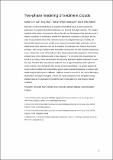| dc.contributor.author | Zhao, Bing | |
| dc.contributor.author | Lai, Adrian C. H. | |
| dc.contributor.author | Law, Adrian Wing-Keung | |
| dc.contributor.author | Adams, E. Eric | |
| dc.contributor.author | Adrian C. H. Lai | |
| dc.date.accessioned | 2016-08-30T21:21:07Z | |
| dc.date.available | 2016-08-30T21:21:07Z | |
| dc.date.issued | 2013-02 | |
| dc.date.submitted | 2012-08 | |
| dc.identifier.issn | 1567-7419 | |
| dc.identifier.issn | 1573-1510 | |
| dc.identifier.uri | http://hdl.handle.net/1721.1/104082 | |
| dc.description.abstract | A sediment cloud release in stagnant ambient fluid occurs in many engineering applications. Examples include land reclamation and disposal of dredged materials. The detailed modeling of the distinct characteristics of both the solid and fluid phases of the sediment cloud is hitherto unavailable in the literature despite their importance in practice. In this paper, the two-phase mixing characteristics of the sediment cloud are investigated both experimentally and theoretically. Experiments were carried out to measure the transient depth penetration and the lateral spread of the sediment cloud and its entrained fluid using the laser induced fluorescence technique, with a range of particle sizes frequently encountered in the field (modeled at laboratory scale). A two-phase model of the sediment cloud that provides detailed predictions of the mixing characteristics of the individual phases is also proposed. The entrained fluid characteristics are solved by an integral model accounting for the buoyancy loss (due to particle separation) in each time step. The flow field induced by the sediment cloud is approximated by a Hill’s spherical vortex centered at the centroid and with the size of the entrained fluid. The particle equation of motion under the effect of the induced flow governs each computational particle. A random walk model using the hydrodynamic diffusion coefficient is used to account for the random fluctuation of particles in the dispersive regime. Overall, the model predictions of the two-phase mixing characteristics are in good agreement with the experimental data for a wide range of release conditions. | en_US |
| dc.description.sponsorship | Singapore. National Research Foundation ( Singapore-MIT Alliance for Research and Technology’s CENSAM IRG research programme) | en_US |
| dc.publisher | Springer Netherlands | en_US |
| dc.relation.isversionof | http://dx.doi.org/10.1007/s10652-013-9271-x | en_US |
| dc.rights | Article is made available in accordance with the publisher's policy and may be subject to US copyright law. Please refer to the publisher's site for terms of use. | en_US |
| dc.source | Springer Netherlands | en_US |
| dc.title | Two-phase modeling of sediment clouds | en_US |
| dc.type | Article | en_US |
| dc.identifier.citation | Lai, Adrian C. H., Bing Zhao, Adrian Wing-Keung Law, and E. Eric Adams. “Two-Phase Modeling of Sediment Clouds.” Environ Fluid Mech 13, no. 5 (February 12, 2013): 435–463. | en_US |
| dc.contributor.department | Massachusetts Institute of Technology. Department of Civil and Environmental Engineering | en_US |
| dc.contributor.department | Massachusetts Institute of Technology. Laboratory for Autonomous Marine Sensing Systems | en_US |
| dc.contributor.mitauthor | Adams, E. Eric | en_US |
| dc.contributor.mitauthor | Adrian C. H. Lai | en_US |
| dc.relation.journal | Environmental Fluid Mechanics | en_US |
| dc.eprint.version | Author's final manuscript | en_US |
| dc.type.uri | http://purl.org/eprint/type/JournalArticle | en_US |
| eprint.status | http://purl.org/eprint/status/PeerReviewed | en_US |
| dc.date.updated | 2016-05-23T12:08:16Z | |
| dc.language.rfc3066 | en | |
| dc.rights.holder | Springer Science+Business Media Dordrecht | |
| dspace.orderedauthors | Lai, Adrian C. H.; Zhao, Bing; Law, Adrian Wing-Keung; Adams, E. Eric | en_US |
| dspace.embargo.terms | N | en |
| dc.identifier.orcid | https://orcid.org/0000-0002-5577-683X | |
| mit.license | PUBLISHER_POLICY | en_US |
